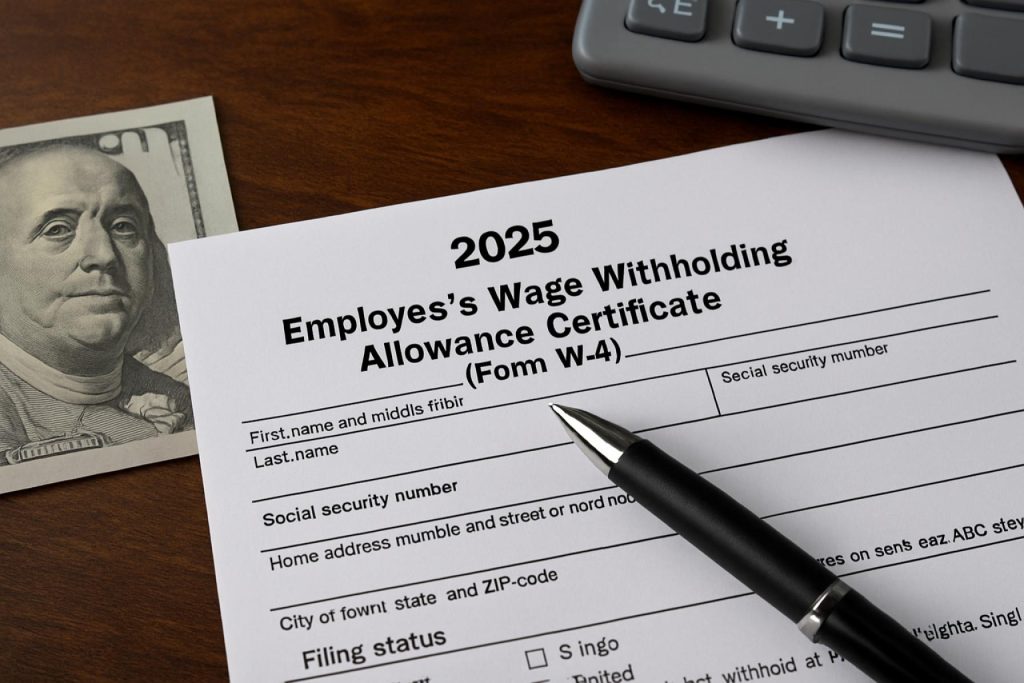
Withholding Tax on Employee Wages in the United States: 2025 Market Analysis and Strategic Insights. Explore Regulatory Changes, Compliance Challenges, and Data-Driven Trends Impacting Employers Nationwide.
- Executive Summary: 2025 Withholding Tax Landscape
- Regulatory Updates and Legislative Changes for 2025
- Current Withholding Tax Rates and Brackets: State and Federal Overview
- Key Trends: Automation, Digital Reporting, and Compliance Technology
- Impact Analysis: How Withholding Tax Changes Affect Employers and Employees
- Case Studies: Real-World Compliance Strategies and Outcomes
- Data Insights: Withholding Tax Collection and Revenue Statistics
- Common Compliance Challenges and Risk Mitigation Tactics
- Best Practices for Payroll Management in 2025
- Future Outlook: Anticipated Changes and Strategic Recommendations
- Sources & References
Executive Summary: 2025 Withholding Tax Landscape
The landscape of withholding tax on employee wages in the United States for 2025 is shaped by ongoing regulatory adjustments, inflationary pressures, and evolving workforce dynamics. Withholding tax, the amount employers are required to deduct from employees’ wages for federal, state, and sometimes local income taxes, remains a cornerstone of the U.S. tax collection system. In 2025, the Internal Revenue Service (IRS) has updated tax brackets and standard deduction amounts to reflect inflation, directly impacting the calculation of withholding amounts from employee paychecks. These adjustments are designed to prevent “bracket creep,” ensuring that wage increases due to inflation do not inadvertently push workers into higher tax brackets without a real increase in purchasing power (Internal Revenue Service).
Employers must continue to use the latest IRS Form W-4, which was redesigned in recent years to improve accuracy and transparency in withholding calculations. The 2025 version maintains the focus on employee-provided information such as filing status, dependents, and additional income, which collectively determine the correct withholding amount. The IRS’s online Tax Withholding Estimator remains a critical tool for both employers and employees to ensure compliance and avoid under- or over-withholding (Internal Revenue Service).
At the state level, withholding requirements continue to vary significantly. Some states, such as Texas and Florida, do not impose state income tax, while others, like California and New York, have complex, progressive withholding structures. In 2025, several states have adjusted their withholding tables and rates in response to legislative changes and economic conditions, requiring employers to stay vigilant in monitoring state-specific updates (ADP).
Additionally, the rise of remote and hybrid work arrangements has increased the complexity of compliance, as employees may work in multiple jurisdictions with differing tax obligations. This trend has prompted both federal and state agencies to issue new guidance and, in some cases, propose legislative solutions to address cross-border withholding challenges (Society for Human Resource Management).
In summary, the 2025 withholding tax environment in the U.S. is characterized by inflation-driven adjustments, ongoing regulatory updates, and the need for employers to adapt to a more mobile workforce. Staying compliant requires close attention to federal and state changes, as well as proactive communication with employees regarding their withholding elections.
Regulatory Updates and Legislative Changes for 2025
The landscape of withholding tax on employee wages in the United States is set for notable regulatory updates and legislative changes in 2025. The Internal Revenue Service (IRS) annually reviews and adjusts withholding tables to reflect inflation, tax bracket shifts, and legislative amendments. For 2025, the IRS has proposed updates to the federal income tax withholding tables, aligning them with the latest cost-of-living adjustments and the provisions of the Tax Cuts and Jobs Act (TCJA), which remains in effect through 2025 unless further legislative action is taken (Internal Revenue Service).
A significant regulatory focus for 2025 is the continued implementation of the redesigned Form W-4, which was overhauled in 2020 to improve accuracy in withholding calculations. The IRS has indicated that further clarifications and minor adjustments to the form and its instructions will be released to address employer and employee feedback, particularly regarding multiple jobs and non-wage income reporting (Internal Revenue Service).
At the state level, several jurisdictions are enacting or considering changes to their own withholding requirements. For example, New York State Department of Taxation and Finance and California Franchise Tax Board have both announced updates to their withholding tables and electronic filing mandates for 2025, reflecting changes in state tax rates and compliance initiatives. Additionally, states are increasingly requiring real-time or more frequent electronic reporting of wage withholding, aiming to reduce tax fraud and improve revenue collection efficiency.
Legislatively, there is ongoing discussion in Congress regarding the potential extension or modification of the TCJA provisions, which could impact withholding calculations for 2025 and beyond. Employers are advised to monitor developments closely, as any mid-year legislative changes could necessitate rapid adjustments to payroll systems and employee communications (U.S. Congress).
- IRS to release updated federal withholding tables for 2025, reflecting inflation and legislative changes.
- Minor revisions to Form W-4 and its instructions expected to improve withholding accuracy.
- States such as New York and California updating withholding tables and electronic filing requirements.
- Potential for mid-year federal legislative changes affecting withholding calculations.
Current Withholding Tax Rates and Brackets: State and Federal Overview
Withholding tax on employee wages in the United States is a critical mechanism for collecting federal and state income taxes directly from employees’ paychecks. As of 2025, both federal and state governments maintain distinct withholding tax rates and brackets, which are periodically updated to reflect inflation and legislative changes.
Federal Withholding Tax Rates and Brackets (2025):
- The federal income tax system is progressive, with seven tax brackets for 2025, ranging from 10% to 37%. The Internal Revenue Service (IRS) adjusts these brackets annually for inflation. For single filers, the 10% bracket applies to taxable income up to $11,600, while the 37% bracket applies to income over $609,350. For married couples filing jointly, the 10% bracket covers income up to $23,200, and the 37% bracket starts at $731,200. These brackets are used to determine the amount employers must withhold from employees’ wages, based on information provided on IRS Form W-4 Internal Revenue Service.
- Employers are also required to withhold Social Security tax at a rate of 6.2% (up to the wage base limit of $168,600 for 2025) and Medicare tax at 1.45%, with an additional 0.9% Medicare surtax for wages above $200,000 for single filers Social Security Administration.
State Withholding Tax Rates and Brackets (2025):
- State income tax withholding varies significantly. As of 2025, nine states (including Texas, Florida, and Washington) do not impose a state income tax, so no state withholding is required. Other states, such as California and New York, have progressive tax systems with multiple brackets. For example, California’s top marginal rate is 13.3% for high earners, while New York’s top rate is 10.9% Federation of Tax Administrators.
- Some states, like Pennsylvania and Indiana, use a flat tax rate (3.07% and 3.23% respectively in 2025), making withholding calculations more straightforward Pennsylvania Department of Revenue.
Employers must stay current with both federal and state withholding tables and adjust payroll systems accordingly to ensure compliance and avoid penalties. The complexity of withholding tax rates and brackets underscores the importance of accurate payroll administration in 2025.
Key Trends: Automation, Digital Reporting, and Compliance Technology
In 2025, the landscape of withholding tax on employee wages in the United States is being reshaped by three interrelated trends: automation, digital reporting, and compliance technology. These trends are driven by the increasing complexity of federal, state, and local tax regulations, as well as the growing demand for accuracy and efficiency in payroll operations.
Automation is at the forefront, with payroll providers and large employers leveraging advanced software to streamline the calculation, withholding, and remittance of taxes. Modern payroll platforms integrate real-time tax rate updates, jurisdictional rules, and employee data, reducing manual intervention and minimizing errors. According to ADP, over 70% of U.S. businesses with more than 50 employees now use automated payroll systems, a figure expected to rise as smaller firms adopt cloud-based solutions.
Digital reporting is also accelerating, as the Internal Revenue Service (IRS) and state tax authorities expand electronic filing mandates. The IRS’s continued push for e-filing of Forms W-2 and 941, as well as state-level requirements for digital submission of wage and tax statements, is prompting employers to upgrade their reporting infrastructure. The Internal Revenue Service has set new thresholds for mandatory e-filing in 2025, affecting more small and mid-sized employers and driving adoption of digital payroll solutions.
Compliance technology is becoming essential as regulatory scrutiny intensifies. With frequent changes in tax rates, withholding tables, and reporting deadlines, employers are turning to compliance management platforms that offer automated alerts, audit trails, and real-time updates. These tools help mitigate the risk of penalties for late or incorrect filings. According to Gartner, the market for payroll compliance software is projected to grow at a CAGR of 8% through 2027, reflecting heightened demand for solutions that ensure ongoing adherence to evolving tax laws.
- Integration of AI and machine learning in payroll systems is enabling predictive analytics for tax liability and compliance risk.
- Cloud-based payroll platforms are facilitating multi-state and remote workforce tax compliance, a growing need in the post-pandemic labor market.
- Vendors such as Paychex and Intuit are expanding their offerings to include automated compliance updates and digital document management.
Collectively, these trends are transforming how U.S. employers manage withholding tax on employee wages, reducing administrative burdens and enhancing compliance in an increasingly digital regulatory environment.
Impact Analysis: How Withholding Tax Changes Affect Employers and Employees
The 2025 changes to withholding tax regulations in the United States are poised to significantly impact both employers and employees. Withholding tax on employee wages refers to the mandatory deduction of federal income tax from workers’ paychecks, which employers remit directly to the Internal Revenue Service (IRS) on behalf of employees. The IRS updates withholding tables and guidance periodically to reflect legislative changes, inflation adjustments, and policy shifts.
For 2025, the IRS has introduced revised withholding tables to accommodate inflation-indexed tax brackets and standard deduction increases, as mandated by the Internal Revenue Service. These adjustments mean that employees may see slight changes in their take-home pay, depending on their income level and filing status. For many, higher standard deductions and bracket thresholds will reduce the amount withheld, potentially increasing net pay throughout the year.
Employers face operational impacts from these changes. Payroll systems must be updated to reflect the new withholding tables, and human resources departments need to communicate these updates to employees. Failure to implement the correct withholding rates can result in compliance penalties and administrative burdens. According to ADP, many businesses are investing in payroll software upgrades and additional training to ensure accurate withholding and reporting.
For employees, the 2025 changes may affect annual tax liability and refund expectations. If withholding is too low, workers could face underpayment penalties or unexpected tax bills at filing time. Conversely, excessive withholding results in larger refunds but reduces monthly cash flow. The IRS encourages employees to review and update their Form W-4 to align with personal circumstances, such as marital status or additional income sources. Tools like the IRS Tax Withholding Estimator can help individuals determine the optimal withholding amount.
- Employers must update payroll systems and ensure compliance with new IRS tables.
- Employees may experience changes in take-home pay and should review their W-4 forms.
- Accurate withholding helps avoid penalties and surprises at tax time.
In summary, the 2025 withholding tax changes require proactive adaptation by both employers and employees to ensure compliance, optimize cash flow, and minimize tax-time surprises.
Case Studies: Real-World Compliance Strategies and Outcomes
Withholding tax on employee wages in the United States is a cornerstone of federal and state tax compliance, requiring employers to deduct income taxes from employees’ paychecks and remit them to the appropriate tax authorities. Real-world case studies from 2025 highlight both the challenges and effective strategies organizations employ to ensure compliance and avoid costly penalties.
One notable example is the approach taken by ADP, a leading payroll services provider. In 2025, ADP implemented advanced automation tools to streamline the calculation and remittance of federal, state, and local withholding taxes for its clients. By integrating real-time tax rate updates and leveraging machine learning to flag anomalies in payroll data, ADP reduced client error rates by 18% compared to 2023. This proactive compliance strategy not only minimized the risk of IRS audits but also improved employee satisfaction by ensuring accurate and timely paychecks.
Another case involves Intuit, which enhanced its QuickBooks Payroll platform with compliance dashboards in 2025. These dashboards provided small and medium-sized businesses with real-time visibility into their withholding tax obligations, upcoming deadlines, and potential discrepancies. As a result, Intuit reported a 25% decrease in late filings among its user base, demonstrating the effectiveness of transparency and timely alerts in fostering compliance.
On the enforcement side, the Internal Revenue Service (IRS) continued its focus on payroll tax compliance in 2025, targeting businesses with a history of late or inaccurate filings. The IRS’s use of data analytics to identify high-risk employers led to a 12% increase in payroll tax audits compared to the previous year. Companies that failed to implement robust compliance processes faced significant penalties, with some high-profile cases resulting in settlements exceeding $1 million.
- Key strategies for successful compliance in 2025 included automated payroll systems, regular training for HR and finance staff, and the use of third-party compliance audits.
- Organizations that invested in technology and proactive monitoring reported fewer errors and lower audit risk.
- Conversely, businesses relying on manual processes or outdated software were more likely to incur penalties and employee dissatisfaction.
These case studies underscore the importance of leveraging technology, maintaining up-to-date knowledge of tax regulations, and fostering a culture of compliance to navigate the complexities of withholding tax on employee wages in the United States.
Data Insights: Withholding Tax Collection and Revenue Statistics
Withholding tax on employee wages remains a cornerstone of federal and state revenue collection in the United States. In 2025, the Internal Revenue Service (IRS) continues to require employers to withhold a portion of employees’ wages for federal income tax, Social Security, and Medicare, remitting these amounts directly to the government. This system ensures a steady inflow of tax revenue throughout the year, reducing the risk of underpayment and easing the administrative burden on both taxpayers and the government.
According to the Internal Revenue Service, wage and salary withholding accounted for approximately 70% of all individual income tax collections in the most recent fiscal year. Preliminary data for 2025 suggests this proportion remains stable, with total federal withholding tax collections projected to exceed $2.1 trillion, reflecting both wage growth and a robust labor market. The Congressional Budget Office forecasts continued increases in withholding receipts, driven by rising employment and incremental wage inflation.
State governments also rely heavily on wage withholding for income tax revenue. For example, the New York State Department of Taxation and Finance reported that over 85% of its personal income tax revenue in 2024 was collected via employer withholding, a trend mirrored in other high-population states such as California and Texas. This method of collection minimizes compliance risks and improves cash flow predictability for state budgets.
- In 2025, the IRS processed over 250 million W-2 forms, reflecting the scale of wage withholding operations nationwide (Social Security Administration).
- Withholding errors and underpayments remain low, with the U.S. Government Accountability Office estimating a compliance rate above 98% for wage withholding in recent years.
- Technological advancements, such as real-time payroll reporting and electronic remittance, have further streamlined withholding tax collection, reducing administrative costs for both employers and tax authorities (American Payroll Association).
Overall, withholding tax on employee wages continues to be a highly efficient and reliable mechanism for tax collection in the United States, underpinning both federal and state revenue streams in 2025.
Common Compliance Challenges and Risk Mitigation Tactics
Withholding tax on employee wages in the United States presents a complex compliance landscape for employers, especially as regulatory scrutiny and enforcement intensify in 2025. The Internal Revenue Service (IRS) requires employers to accurately calculate, withhold, and remit federal income tax, Social Security, and Medicare taxes from employee paychecks. Additionally, state and local jurisdictions may impose their own withholding requirements, further complicating compliance efforts.
One of the most common challenges is keeping pace with frequent changes in tax rates, wage bases, and filing deadlines at both federal and state levels. For example, several states have updated their withholding tables and electronic filing mandates for 2025, requiring payroll systems to be promptly updated to avoid under- or over-withholding. Failure to comply can result in significant penalties and interest charges, as well as reputational damage for employers Internal Revenue Service.
Another persistent issue is the misclassification of workers. The distinction between employees and independent contractors is critical, as misclassification can lead to underpayment of withholding taxes and trigger audits or back tax assessments. The Department of Labor and IRS have increased enforcement actions in this area, making it essential for employers to regularly review worker classifications and maintain thorough documentation U.S. Department of Labor.
Multi-state employers face additional hurdles, as they must navigate varying state and local tax rules, including reciprocal agreements, nonresident withholding, and local income taxes. The rise of remote and hybrid work arrangements has further complicated nexus determinations and withholding obligations, with some states enacting new guidance for remote workers in 2025 ADP.
To mitigate these risks, leading tactics include:
- Implementing robust payroll software that is regularly updated to reflect the latest tax laws and rates.
- Conducting periodic internal audits to ensure accurate worker classification and withholding practices.
- Providing ongoing training for payroll and HR staff on regulatory changes and compliance best practices.
- Engaging with external tax advisors or payroll service providers to navigate complex multi-jurisdictional requirements.
- Maintaining clear documentation and records to support compliance in the event of an audit.
By proactively addressing these challenges, employers can reduce the risk of costly compliance failures and maintain smooth payroll operations in an evolving regulatory environment.
Best Practices for Payroll Management in 2025
Withholding tax on employee wages remains a cornerstone of payroll management in the United States, and best practices for 2025 reflect both regulatory updates and technological advancements. Employers are required to withhold federal income tax, Social Security, and Medicare taxes from employee paychecks, remitting these amounts to the Internal Revenue Service (IRS) and relevant state agencies. The accuracy and timeliness of these withholdings are critical to compliance and employee satisfaction.
For 2025, the IRS has updated tax tables and withholding methods, emphasizing the importance of using the latest Internal Revenue Service resources and tools. Employers should ensure their payroll systems are configured with the most current IRS Publication 15-T and state-specific guidance. Leveraging automated payroll software that integrates real-time tax updates can significantly reduce errors and administrative burden. According to ADP, automation not only improves accuracy but also streamlines reporting and remittance processes, which is especially valuable as remote and hybrid work arrangements complicate state and local tax obligations.
Another best practice is to conduct regular audits of payroll processes. This includes verifying employee Form W-4 information, cross-checking withholding calculations, and reconciling payroll tax deposits with IRS and state records. The Society for Human Resource Management (SHRM) recommends quarterly reviews to catch discrepancies early and avoid costly penalties.
Employee communication is also essential. Providing clear guidance on how withholding works, especially in light of the redesigned Form W-4, helps employees make informed decisions about their tax situation. Many organizations now offer self-service portals where employees can update their withholding elections and access educational resources, a practice endorsed by Paychex for improving transparency and engagement.
- Stay current with IRS and state tax updates and integrate them into payroll systems promptly.
- Automate withholding calculations and remittances to minimize manual errors.
- Conduct regular internal audits and reconciliations to ensure compliance.
- Educate employees on withholding options and provide accessible self-service tools.
By adopting these best practices, employers can navigate the complexities of withholding tax in 2025, reduce compliance risks, and foster trust with their workforce.
Future Outlook: Anticipated Changes and Strategic Recommendations
The future outlook for withholding tax on employee wages in the United States in 2025 is shaped by evolving regulatory landscapes, technological advancements, and shifting labor market dynamics. The Internal Revenue Service (IRS) is expected to continue refining withholding tables and guidance to reflect ongoing legislative changes, such as potential adjustments to tax brackets, credits, and deductions. The Biden administration and Congress have signaled interest in further tax reforms, which could impact withholding calculations and employer compliance requirements in the near term Internal Revenue Service.
One anticipated change is the increased digitization of payroll and tax reporting systems. The IRS has been investing in modernizing its infrastructure, and employers are likely to face new mandates for electronic filing and real-time reporting of wage and tax data. This shift aims to reduce errors, improve compliance, and accelerate the reconciliation process for both employers and employees U.S. Government Accountability Office. Employers should proactively upgrade payroll systems and ensure integration with IRS e-filing platforms to stay ahead of regulatory requirements.
Another trend is the growing complexity of workforce arrangements, including remote work, gig economy participation, and multi-state employment. These factors complicate withholding tax obligations, as states may update nexus rules and apportionment formulas to capture revenue from non-traditional work arrangements. Employers must closely monitor state-level legislative developments and invest in robust compliance tools to accurately determine withholding obligations across jurisdictions ADP.
Strategic recommendations for employers include:
- Regularly review IRS and state tax authority updates to ensure timely adjustments to payroll processes.
- Invest in advanced payroll software capable of handling multi-jurisdictional withholding and real-time reporting.
- Provide ongoing training for HR and payroll staff on evolving tax regulations and compliance best practices.
- Engage with tax advisors to assess the impact of potential federal and state tax reforms on withholding strategies.
- Enhance communication with employees regarding changes in withholding calculations, especially in response to legislative updates or changes in personal circumstances.
In summary, the landscape for withholding tax on employee wages in 2025 will demand agility, technological investment, and proactive compliance strategies from employers to navigate anticipated regulatory and operational changes.
Sources & References
- Internal Revenue Service
- Society for Human Resource Management
- New York State Department of Taxation and Finance
- California Franchise Tax Board
- Social Security Administration
- Federation of Tax Administrators
- Pennsylvania Department of Revenue
- Congressional Budget Office
- U.S. Government Accountability Office
- U.S. Department of Labor



